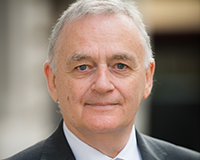 On Tuesday CBRE pulled a crowd of 400 to the Mayfair hotel, just off Piccadilly, W1, by asking a brave question: booming London – how long will it last?
On Tuesday CBRE pulled a crowd of 400 to the Mayfair hotel, just off Piccadilly, W1, by asking a brave question: booming London – how long will it last?
It would have been foolish, perhaps career suicide, for global head of research Nick Axford to answer: “The end is nigh.” Instead, he and his colleagues Kevin McCauley and Neil Blake delivered a detailed, balanced and reasoned argument, using statistics, to show why it is all going to be fine for several years to come.
The stats were followed by a panel discussion, led by Axford, who turned 50 at the weekend. A hell of a dancer in his day, I seem to remember. The three speakers were the ebullient Mike Hussey of Almacantar; Tony Brown, the cerebral chief investment officer of M&G Real Estate; and Trevor Williams, an economist at Lloyds Bank, who was wearing red comedy socks. These stood in contrast to the gravity of his good observations.
Williams was bullish, Brown was cautiously optimistic and Hussey enjoyably provocative. He said: “This is the first presentation I’ve been to in nine years, so you can see what I think about stats.” Axford remained calm.
Hussey continued. “Bottom up, bottom up, that’s how it works. It’s all about getting the right sites and doing the sums. These things take six to 10 years to develop,” said the
man who bought CentrePoint, WC1, in 2011 and began work this year.
I was sitting by two of the most astute developers in London. One occasionally raised his eyebrows, but said no more. The other turned to me at the end of the session and said this: “Look, trees don’t grow to the sky. The central London residential market has gone, thanks to high prices. Give me one good reason to believe the commercial
market is immune from the same forces.”
The CBRE researchers did come up with good reasons. But then, they would…
The wizard of ONS
CBRE’s confidence in the future of London is rightly founded on Office of National Statistic estimates, which forecast that the capital’s current population of 8.3m will rise by 13% to 9.4m in 2022 and to 10m by 2029. Numbers were published before the ONS upgraded estimates last week revealing that the UK’s population could rise by 10m to 74.3m in 25 years’ time.
And the rest.
The figures are based on net migration falling from 330,000 in the year to March 2015 to 256,000 in the current year and staying there.
What’s this got to do with the price of property? Well, so far none of these numbers has been crunched into likely demand for homes, leisure and office space. Imagine what fun that will be when councils are finally asked to add even more space into their local plans.
Hot ideas from Brazier
Good to see Alex Brazier of the Bank of England venturing views on how the sector could mitigate the severity of the next downturn if everyone stuck to defined levels of debt. The proposal put together by Nick Scarles of Grosvenor is “music to the ears” of the Bank, said Brazier.
More interesting is what the director of financial stability said next. “In a matter of months the Bank will start reporting market-wide indicators of valuations and gearing based upon cash flows.” Well, it won’t do any harm, and might do some good.
But, as in 2005-07, it is the uncontrollable cascade of foreign money that sinks the market. Proposals on how the Bank could exercise even the slightest control would be appreciated. Perhaps after the next crash?
What’s the flipping price?
As part of an ongoing service to reveal the truth about soggy residential prices south of the river, £695,888 is how much an off-plan buyer wants for an 817 sq ft, one-bed-flat on the 22nd floor of One The Elephant, a 37-storey block being built by Lend Lease at the Elephant & Castle, SE1. That’s £852 per sq ft.
Is that more or less than the flipper has contracted to pay? No idea. Lend Lease seems shy about revealing prices on the development’s website.










